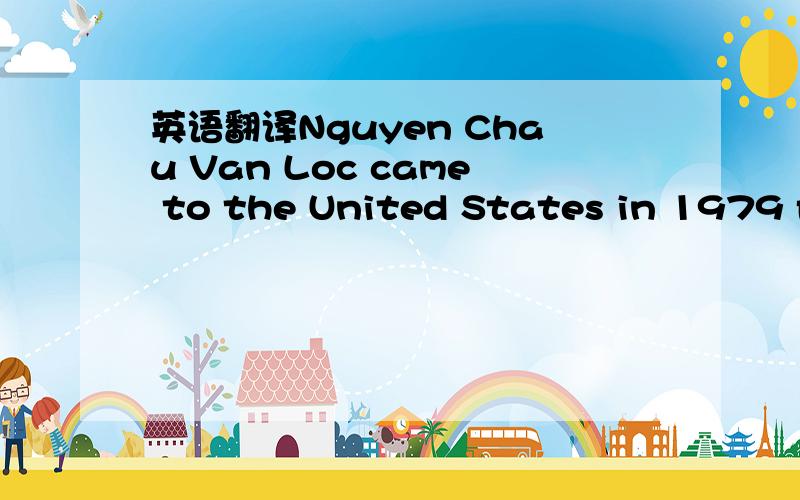英语翻译Nguyen Chau Van Loc came to the United States in 1979 from Vietnam.His first impression of the United States was very positive.He was particularly impressed with the way Americans and put technology to work for them.Americans have machine
来源:学生作业帮助网 编辑:作业帮 时间:2024/05/12 14:44:32

英语翻译Nguyen Chau Van Loc came to the United States in 1979 from Vietnam.His first impression of the United States was very positive.He was particularly impressed with the way Americans and put technology to work for them.Americans have machine
英语翻译
Nguyen Chau Van Loc came to the United States in 1979 from Vietnam.His first impression of the United States was very positive.He was particularly impressed with the way Americans and put technology to work for them.Americans have machines to take them upstairs and downstairs,give them money at the bank,and even open doors for them,He felt that this new environment offered him many exciting opportunities.
However,Loc quickly found himself unprepared to take advantage of these opportunities.He knew almost no English.Even when he knew what to say on a bus or in a store,no one understood him,and he had to repeat and repeat.In Vietnam,Loc was a technician,but in the US,he didn’t have enough experience compared with other people.He had trouble finding a job.He felt that he did not have an important role or position in the city and missed the security and friendliness of his town in Vietnam.He felt that he would never learn English or feel happy in the United States.He began to feel very depressed and homeesick.
Loc was lucky because there was a counselor in his English program.This counselor helped loc to understand that his feelings were normal and that they were only a stage in his adjustment to this new culture.Loc began to look around him and to talk to other Vietnamese.He saw that many others felt the same way he did.Some,in fact,were more disoriented than he was and were afraid to go out into the city.
1,______Loc came from Vietnam.
2,______Loc is married.
3,______Loc came to the United States in 1977.
4,______Loc had a positive attitude about American technology.
5,______Loc did not have a job in Vietnam,
6,______A counselor helped Loc.
7.______The counselor was a woman.
8.______No one felt the same way that Loc did.
9.______People understood Loc's English easlly.
10._____Loc never thinks about Vietnam now.
英语翻译Nguyen Chau Van Loc came to the United States in 1979 from Vietnam.His first impression of the United States was very positive.He was particularly impressed with the way Americans and put technology to work for them.Americans have machine
题目都没有,何来答案一说.
Photos that you might have found down the back of your sofa are now big business!
In 2005, the American artist Richard Prince’s photograph of a photograph, Untitled (Cowboy), was sold for $ 1, 248...
全部展开
Photos that you might have found down the back of your sofa are now big business!
In 2005, the American artist Richard Prince’s photograph of a photograph, Untitled (Cowboy), was sold for $ 1, 248, 000.
Prince is certainly not the only contemporary artist to have worked with so-called “found photographs”—a loose term given to everything from discarded(丢弃的) prints discovered in a junk shop to old advertisements or amateur photographs from a stranger’s family album. The German artist Joachim Schmid, who believes “basically everything is worth looking at”, has gathered discarded photographs, postcards and newspaper images since 1982. In his on-going project, Archiv, he groups photographs of family life according to themes: people with dogs; teams; new cars; dinner with the family; and so on.
Like Schmid, the editors of several self-published art magazines also champion (捍卫) found photographs. One of them, called simply Found, was born one snowy night in Chicago, when Davy Rothbard returned to his car to find under his wiper(雨刷) an angry note intended for some else: “Why’s your car HERE at HER place?” The note became the starting point for Rothbard’s addictive publication, which features found photographs sent in by readers, such a poster discovered in our drawer.
The whole found-photograph phenomenon has raised some questions. Perhaps one of the most difficult is: can these images really be considered as art? And if so, whose art? Yet found photographs produced by artists, such Richard Prince, may riding his horse hurriedly to meet someone? Or how did Prince create this photograph? It’s anyone’s guess. In addition, as we imagine the back-story to the people in the found photographs artists, like Schmid, have collated (整理), we also turn toward our own photographic albums. Why is memory so important to us? Why do we all seek to freeze in time the faces of our children, our parents, our lovers, and ourselves? Will they mean anything to anyone after we’ve gone?
那被你在你的沙发下后面找到的照片现在是大笔生意!
在2005年,美国艺术家Richard Prince的照片,无标题的(牛仔),以 $ 1, 248, 000被卖了。
Prince的确不是当代唯一的艺术家。他与所谓的“found photographs”—— 一个在不固定的期限里从旧货店发现的被丢弃的印刷品对旧广告或从一个陌生的家庭册页的非职业照片。 德国艺术家Joachim Schmid,相信“基本上一切值得看”,会集了被丢弃的照片、明信片和报纸图片自1982年以来。 在他持续的项目, Archiv,他根据题材编组家庭生活的照片: 有狗的人们; 队; 新车; 家庭的晚餐; 等等。
就像Schmid,这位自已出版几本艺术杂志编辑,也捍卫这些被找到的照片。 其中的一个,仅仅被叫作“Found”,是出生一多雪的夜在芝加哥,当Davy Rothbard回到他的汽车发现在他的雨刷之有一张的恼怒的字条: “为什么在这里,您的汽车在她的地方?”笔记成为了Rothbard’s致瘾出版物的,起点特点发现照片读者送,在我们的抽屉发现的这样海报。
The整体发现照片现象提出了有些问题。 或许一最困难是: 这些图象真的能被被认为是艺术吗? 如果可以,那是谁的艺术? 被找到的照片由艺术家,这样Richard Prince生产了,可以仓促地骑着他的马遇见某人? 或者王子怎么创造了这张照片? 这是大家的猜测。 另外,当我们想象这些找到的照片的艺术家们(比如Schmid)背后故事的时候,我们也转动往我们自己的摄影册页。 为什么是记忆很重要对我们? 我们所有寻求为什么结冰在计时我们的孩子、我们的父母,我们的恋人和我们自己? 它们是否将意味是在我们离去后的任何人的任何一切?
收起
阮洲Van Loc在1979年从越南来到美国。他对美国的第一印象是非常积极的。他特别欣赏美国人的方式和技术来为他们工作。美国人机器带他们楼上和楼下,给他们的钱在银行,甚至为他们打开大门,他觉得这个新的环境给了他许多令人兴奋的机会。
然而,Loc很快发现自己没有准备利用这些机会。他知道alm...
全部展开
阮洲Van Loc在1979年从越南来到美国。他对美国的第一印象是非常积极的。他特别欣赏美国人的方式和技术来为他们工作。美国人机器带他们楼上和楼下,给他们的钱在银行,甚至为他们打开大门,他觉得这个新的环境给了他许多令人兴奋的机会。
然而,Loc很快发现自己没有准备利用这些机会。他知道alm
收起